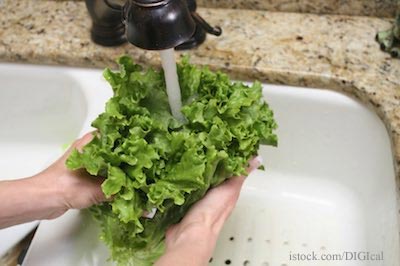The Partnership for Food Safety Education held a webinar earlier this month all about handling produce and food safety. Dr. Linda Verrill of the FDA’s Center for Food Safety and Applied Nutrition (CFSAN), Ashely Eisenbeiser of Food Marketing Institute, and Ellie Krieger, author and nutritionist, were the speakers. Today we will tell you about Dr. Verrill’s information and advice.
 Dr. Verrill spoke about studies and surveys conducted by CFSAN about produce handling and safety. She said that 14 pathogens represent over 95% of annual illnesses and hospitalizations in the U.S. And five of those pathogens are responsible for more than 90% of the health burden: Salmonella, Toxoplasma gondii, norovirus, Listeria monocytogenes, and Campylobacter. In fact, Salmonella and produce is in the top 5 of pathogen-commodity pairings that cause foodborne illness outbreaks.
Dr. Verrill spoke about studies and surveys conducted by CFSAN about produce handling and safety. She said that 14 pathogens represent over 95% of annual illnesses and hospitalizations in the U.S. And five of those pathogens are responsible for more than 90% of the health burden: Salmonella, Toxoplasma gondii, norovirus, Listeria monocytogenes, and Campylobacter. In fact, Salmonella and produce is in the top 5 of pathogen-commodity pairings that cause foodborne illness outbreaks.
Increases in consumption, desire for year-round fresh produce, increases in produce transport, more cutting and coring of produce in the field, and more fields close to animal production are all driving contamination of produce. Since 21% of outbreaks are linked to food prepared and eaten at home, and since only 8% of consumers believe that home is a source of contamination, consumer education in safe produce handling is essential.
When you purchase produce, make sure it isn’t bruised or damaged. Store perishable fruits and veggies at 40 degrees F or less to slow bacterial growth. Remember that even if you plan to peel the produce, it should be washed. Use a vegetable brush to scrub firm-skinned produce under running water, and wash delicate produce by rubbing and rinsing under running water. Always keep produce separate from raw meats, poultry, eggs, and seafood. Experts recommend that you do not wash bagged, pre-washed produce because the home environment increases the risk of cross-contamination.
Dr. Verrill said that 25% of home refrigerators are set at too warm a temperature. And if consumers do wash produce, they don’t use correct methods. Many don’t wash their hands or cutting boards before preparing food. And many people eat risky foods, including undercooked eggs, raw milk, and undercooked hamburger, that increases their risk of foodborne illness.
A 2010 survey found that 63% of consumers think that fruits and vegetables are not likely to make you sick. Having said that, almost 100% of consumers wash strawberries and tomatoes. About half wash cantaloupe. And more than half wash bagged, pre-cut lettuce.
There have been significant improvements in food handling from 1998 through 2010, according to the FDA. Researchers have found that produce safety education programs are successful, and that hand hygiene may be the best focus for improving produce handling behavior.
Studies about how different groups approach produce safety are interesting. Those who have the worst food handling practices include males, Caucasians, young adults between the ages of 18 and 29, much older adults, those who are the most educated, and those with higher incomes. Researchers have found that those groups are more likely to engage in risky behavior, partly because they have health insurance. Consumers not in those groups have better food handling behaviors because they have more contact with government food programs, which include education.




